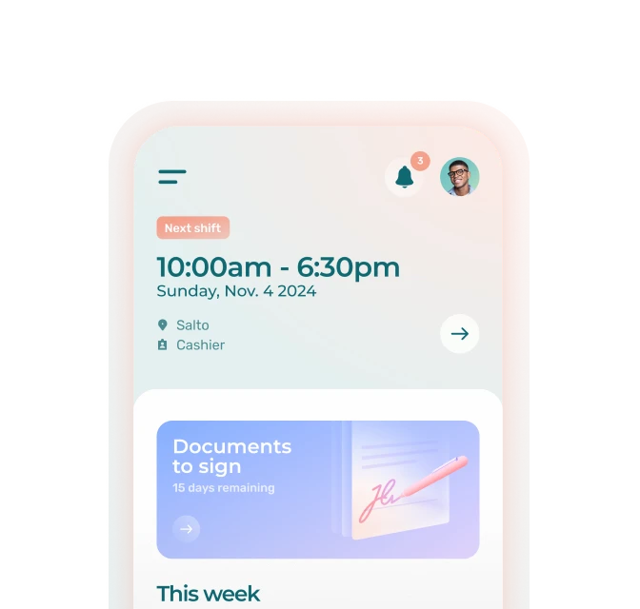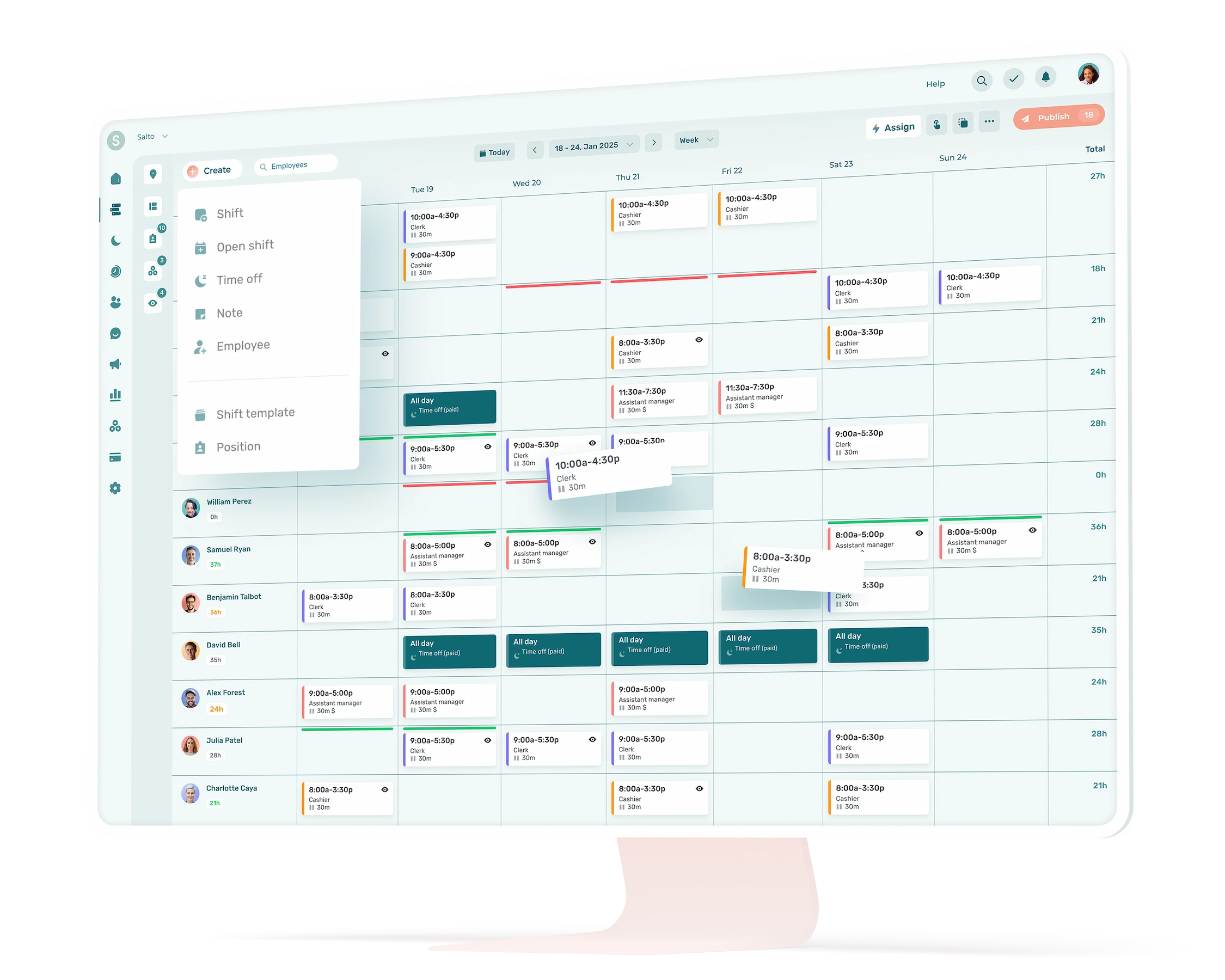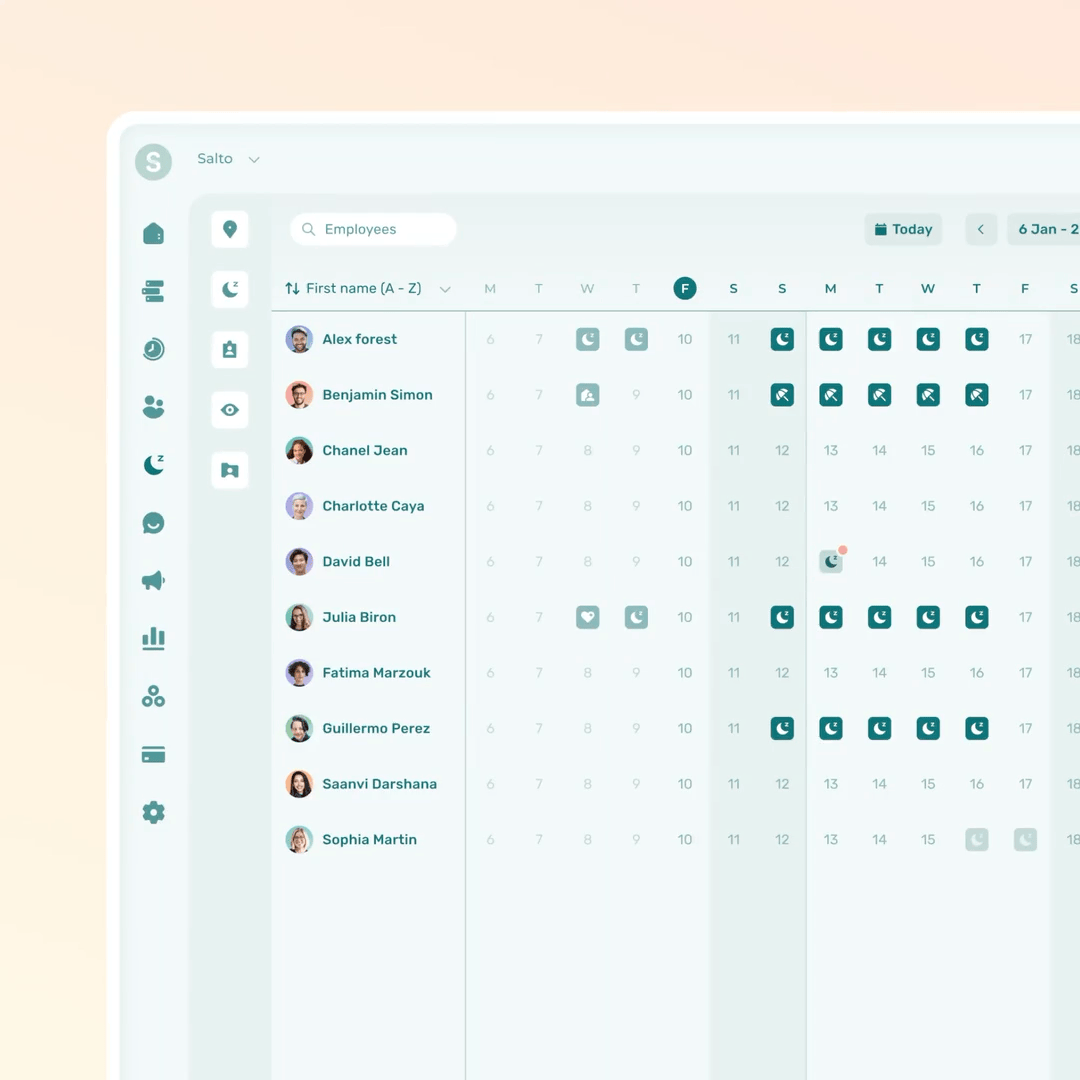Flexible Scheduling Made Easy: Empower Your Team Without Compromising Structure
Key takeaways
- Flexible scheduling (shift swaps, open shifts, self-managed availability, flex time, compressed workweek) increases employee autonomy while maintaining coverage for SMBs.
- Make it work with a clear framework: fair shift assignment, time-off request deadlines, manager-approved swaps, and publishing the schedule at least two weeks in advance.
- Done right, flexibility boosts retention and engagement, lowers absenteeism and stress, and streamlines operations in healthcare, retail, restaurants, and more.
- Roll out gradually: involve the team, pilot one option at a time, and centralize employee scheduling in modern employee scheduling software to stay in control.
- Agendrix helps capture availability/preferences, structure shift swaps, and publish reliable schedules—even in variable-shift environments.
Implementing a flexible work schedule is a great way to accommodate and empower your staff. Learn about the key challenges and benefits, and follow our practical guide to putting flex scheduling into action.
For SMBs in industries where shift coverage is essential such as healthcare, retail, and restaurants, flexible scheduling isn’t out of reach. When implemented thoughtfully, it can improve staff planning, better meet employee expectations, and ease the burden on managers.
According to a FlexJobs survey, 92% of respondents believe that a flexible work schedule would make them happier overall.
Why Talk About Flexible Scheduling?
The message is clear: flexibility is no longer a luxury. It has become a strong expectation among workers. Shift workers want schedules that help them better balance their personal and professional lives.
For managers, offering flexible scheduling can feel complicated, even unrealistic. This is especially true when running a small team and constantly juggling unexpected changes. Why make an already complex puzzle even harder?
Yet when used properly, a flex work schedule can be a real organizational asset.
It improves retention, reduces stress, and makes employee scheduling easier. This guide explores flexible scheduling through hands-on tips, digital tools, and proven examples tailored to the needs of small and medium-sized businesses.
What Is Flexible Scheduling?
Flexible scheduling is a way of organizing work that gives employees some freedom in choosing their hours while still meeting their employer’s needs.
Some examples include:
- Prioritizing certain shifts (morning, evening, or weekend)
- Allowing shift swaps between coworkers
- Adjusting schedules based on personal availability (appointments, exams, a sick child, etc.)
- Spreading hours differently across the workweek
- Choosing arrival and departure times
💡 Flexibility does not mean a lack of structure. It is based on clear rules that give employees more autonomy while allowing managers to stay on track. The success of a flexible work schedule depends on setting defined parameters rather than leaving things to chance.
Common Types of Flexible Scheduling
Depending on your organization, team size, and the tools you use, some options may be easier to implement than others when introducing flexible scheduling. Here are the most common approaches:
Rotating Schedules
Employees alternate between different shifts (day, evening, night) on a set rotation (weekly, biweekly, or monthly). Rotating schedules help distribute less popular shifts more fairly. However, they require careful planning to avoid burnout.
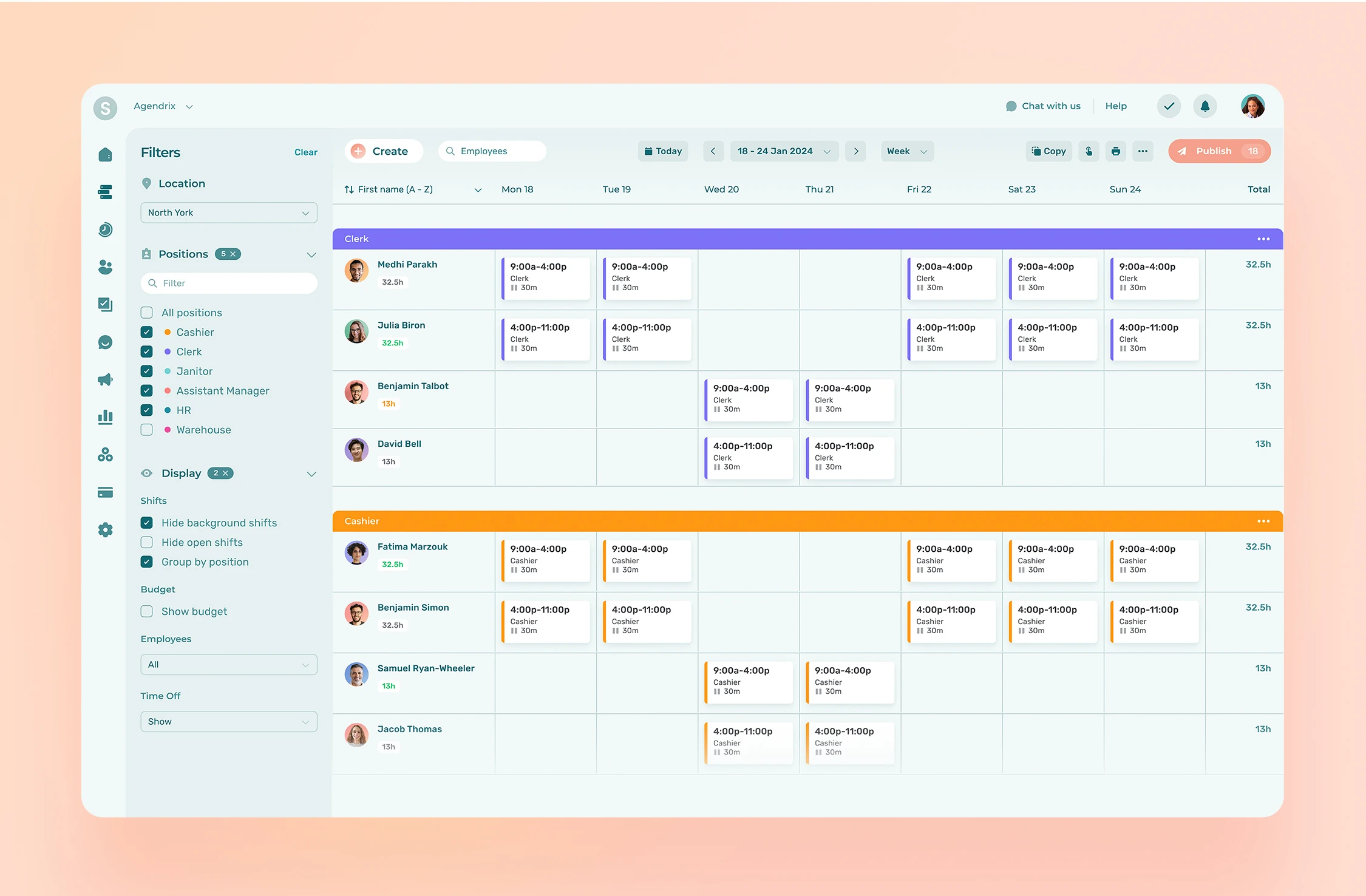
Shift Swaps
Employees can request or offer shift swaps directly with one another. The change is either approved by a manager or automatically processed according to predefined rules in a scheduling software.
Open Shifts
Some shifts are posted as open, and employees can volunteer for them based on their availability. For example, a restaurant manager might post an open Saturday night shift that is filled on a first-come, first-served basis.
Open shifts encourage autonomy and involvement, allowing your team to take part in building the schedule. They can also be helpful during busy periods.
Self-Managed Availability
Employees share their availability and scheduling preferences in advance. Managers then build the schedule while taking these details into account.
For example, a pharmacy clerk might only be available on Monday, Wednesday, and Thursday evenings, for a maximum of 20 hours per week.
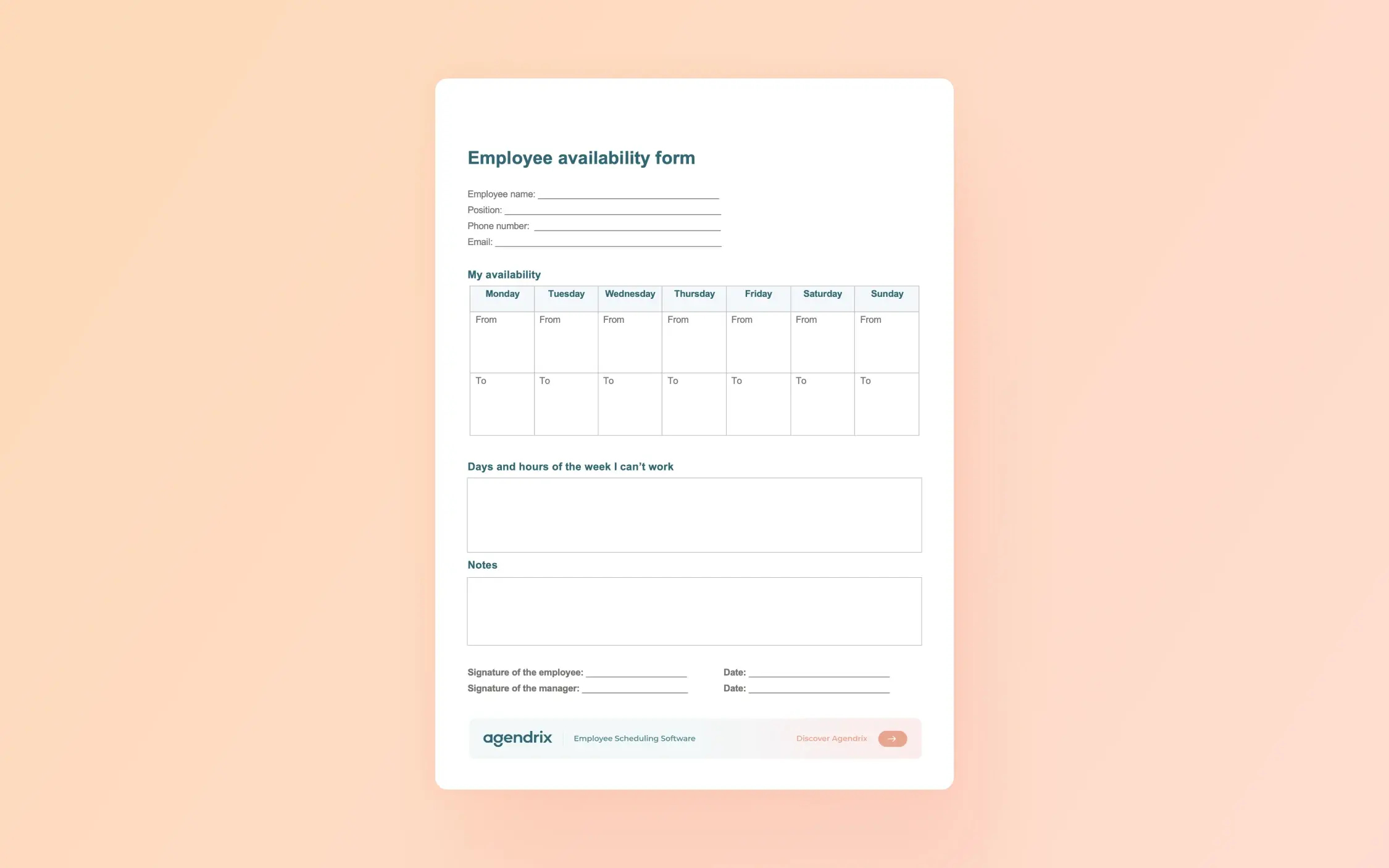
Compressed Workweek
Employees work the same number of hours but over fewer days. This creates longer weekends and can also reduce commuting time.
For instance, a healthcare worker might work four 10-hour days instead of five 8-hour days, freeing up Fridays for a college class.
Flex Time
Employees can choose their start and end times within a defined range. This type of flexible scheduling is common in call centers and office environments.
For example, an employee may choose to work from 7 a.m. to 3 p.m. instead of 9 a.m. to 5 p.m. in order to pick up their child from school.
Don’t Be Afraid to Combine Different Forms of Flexible Scheduling
These practices can be combined. For example, a company might allow employees to manage their own availability, encourage shift swaps when needed, and use open shifts during certain periods. What matters most is choosing the approach that best fits your reality.
Flexible Scheduling Challenges
Offering flexibility doesn’t mean letting employees do whatever they want, whenever they want. On the contrary, effective flexibility depends on clear rules and solid structure.
Here are some common challenges managers face when introducing flexible work schedules, along with practical ways to address them.
Challenge #1: Fear of Losing Control
When people think of flexibility, they often picture an environment where everyone makes their own rules as they please. Many managers believe flexible scheduling is synonymous with free-for-all.
Employees showing up late or not at all. Struggling to fill shifts. Being short-staffed during busy periods. Failing to maintain consistent customer service. The list goes on. These are all real headaches for managers.
But remember: these challenges aren’t unique to flexible work schedules. They usually arise whenever scheduling is handled in an improvised or poorly structured way.
How to handle it:
The key to avoiding confusion is to set clear scheduling guidelines: priority shifts, deadlines for time-off requests, rules around shift swaps, and so on.

📌 With employee scheduling software, you can track schedules in real time, validate swaps, and keep a clear overview without losing control.
Agendrix really helps us connect with our employees. And when we’re flexible with their schedules, they’re more inclined to give us more of their time in return.
— Maggie Fournier, HR manager at Lévis Convention and Exhibition Centre and Hotel
Challenge #2: When Flexibility Feels Unfair
If some employees have more flexibility than others, tensions can emerge. A sense of unfairness can also arise if the same people always get the easier or better-paying shifts, or if they consistently avoid working weekends.
How to handle it:
Set fair rules and make sure they’re clearly communicated to your entire team. Apply them consistently, without exceptions, and adjust them as needed to fit your organization’s reality.
For example, you might rotate weekend shifts so that every employee gets at least one weekend off per month.
📌 Transparency and organization are key to distributing schedules fairly and avoiding unnecessary frustration.
Challenge #3: The Puzzle of Employee Scheduling
The more requests, exceptions, and preferences there are to manage, the longer and more complex scheduling becomes. A manager can easily spend hours juggling everyone’s demands to create a schedule that meets both business needs and employee expectations.
How to handle it:
Centralize your schedules in a tool that offers recurring shift templates. Ask employees to update their availability and preferred weekly hours directly in the tool. Use it as well to handle time-off requests, shift swaps, and attendance tracking.
📌 Some scheduling software (like Agendrix 😉) can even generate recurring schedules based on your rules. You can also see time-off requests, approved or pending, directly in the planner.
Challenge #4: Scattered Communication
It’s easy to lose track of things when requests come in from everywhere: sticky notes, text messages, phone calls, Facebook chats, quick huddles, and more. Who asked for what, when, and what was approved or denied?
How to handle it:
Centralize all employee requests in a single platform. Not only does this keep a record of every exchange, but it also saves you from feeling like you’re going through an obstacle course every time a new request comes in.
📌 A good scheduling tool lets employees make requests directly in the platform, communicate with their manager and coworkers, and receive automatic notifications when changes are made to their schedule.
Flexible Scheduling Works, Here’s Why
When implemented properly, flexible scheduling delivers tangible results. It becomes a powerful lever for both your team and your organization.
Whether it’s to promote well-being, strengthen engagement, better manage peak periods, or optimize operations, the benefits are numerous. And everyone wins.
Benefits for Managers and your Organization
According to a FlexJobs study, 80% of employees say they would be more loyal to their employer if they offered greater flexibility.
Flexible scheduling ➡️ Improved retention
A rigid schedule is one of the top reasons employees quit. If they can’t take time off, attend an appointment, or handle family duties, they’ll look for an employer who supports their reality.
💡 Offering more flexibility reduces the temptation to look for another job.
Balancing work and personal life ➡️ Reduced absenteeism and lateness
A proactive manager might adjust the schedule of an employee who is consistently late on Thursday mornings because they need to drop off their children at daycare.
💡 Greater flexibility helps reduce lateness caused by external constraints (like family responsibilities) and lowers absenteeism.
Less stress ➡️ Increased productivity
Well-rested employees are more organized, which makes them more productive.
💡 A flexible work schedule reduces stress and adapts working hours to the needs of both your team and your business.
More autonomy ➡️ Better work environment
A team that feels its needs are heard is a more engaged team.
💡 Offering flexibility sends a clear message of trust, openness, and adaptability, which strengthens your company culture.
Benefits for Employees
A Deloitte study revealed that workplace flexibility improves job satisfaction and morale for about 30% of workers.
Flexible work schedule ➡️ Higher satisfaction and motivation
A schedule that respects each person’s preferences helps boost day-to-day morale. Employees feel they have more control over their professional lives, which boosts motivation.
Balancing work and personal life ➡️ More sustainable lifestyle
Whether it’s childcare, caring for a relative, or attending classes, flexibility allows employees to plan around personal responsibilities without having to compromise.
Less stress ➡️ Better mental and physical health
Flexibility makes it easier for employees to meet their personal needs: sleep, medical appointments, exercise, etc., which has a direct positive impact on overall well-being.
More autonomy ➡️ A sense of trust and recognition
Offering flexibility shows trust. Employees feel more empowered, which can strengthen engagement and loyalty to the organization.
Flexible Scheduling: A Smart Way to Boost Team Performance
If there’s one takeaway for managers, it’s the strong link between flexibility and productivity.
Flexible schedules aren’t a barrier to smooth operations. They’re what keep everything running smoothly.
See for yourself the potential gains:
Unpredictable Schedules vs. Flexibility: Reducing Stress and Absenteeism in Healthcare
In sectors with atypical hours, such as healthcare, unpredictable schedules can increase stress and harm employee health. However, according to the French National Research and Safety Institute (INRS), when workers have a say in their schedules, the impact on their well-being can be positive.
This autonomy helps reduce chronic fatigue, improve sleep hygiene, and lower absenteeism. It also contributes to better quality of care in healthcare facilities.
Structured Flexibility Boosts Performance and Engagement in Retail
Retail operations often rely on variable schedules: evenings, weekends, and split shifts. According to Dares, nearly one in two retail workers in France is regularly exposed to these conditions.
It’s precisely in such demanding environments that structured flexible scheduling can make a real difference. Allowing employees to choose certain shifts, swap with coworkers, or share their availability in advance is more than a favor, it’s a strategy.
The result? Less fatigue, better work-life balance, and, most importantly, more engaged teams. Many employers also see greater staff stability and fewer errors on the floor.
Boosting Performance With Flexible Scheduling
Here are some of the gains of putting flexible scheduling into practice.
1. Publishing Schedules in Advance
A win for you and your team. When rules are clear and you know employee availability and time-off requests ahead of time, it becomes much easier to publish schedules quickly.
Aim to post schedules at least two weeks in advance. This allows employees to plan their personal lives while reducing last-minute adjustments on your end.
2. Structured Shift Swaps
Instead of forbidding or improvising shift swaps, offer this option in a structured way. This reduces absenteeism and lateness while encouraging accountability among employees.
- Allow swaps between coworkers in the same role or who have completed the required training
- Require manager approval (or not)
- Limit swaps to a set timeframe (ex.: at least 24 hours in advance)
A scheduling software can automate these exchanges based on your chosen rules, such as employee roles, manager approval, and deadlines.
3. Fair Shift Assignment
Introducing flexible schedules gives you the chance to review shift assignment practices and make them more equitable. For example:
- Rotate teams for weekend or evening shifts
- Balance total hours per employee while considering preferences and availability
- Prioritize more experienced staff for high-demand shifts
4. Self-Managed Availability
When employees are responsible for keeping their availability up to date, they gain more autonomy. This also prevents managers from having to deal with last-minute texts when building the schedule. Planning becomes easier without hurting flexibility.
The result: more autonomous and satisfied employees, and lighter workloads for managers.
5. Integrating Employee Preferences
Some organizations ask employees to share their preferred shifts (ex.: “I prefer mornings” or “I’d rather not work Sunday nights”). While you can’t guarantee every request, offering this option shows goodwill.
This approach increases job satisfaction and strengthens motivation.

Practical Guide to Flexible Scheduling for SMBs
Offering flexible schedules is not only possible but also highly beneficial, even in fast-paced environments like SMBs.
Here’s a five-step guide to implementing flexibility while still maintaining quality customer service.
1. Understand Your Company’s Specifics
SMBs often face common challenges:
- Small teams where every absence has a bigger impact
- Work hours dictated by customer demand
- Management responsibilities concentrated on a single manager
But they also have advantages:
- Direct communication between team members
- Quick adaptability and less bureaucracy
- A close-knit culture that fosters trust and collaboration
Identify the challenges and strengths of your organization to better address the realities of flexible scheduling.
2. Start Small, but Smart
Flexibility doesn’t happen overnight. To minimize mistakes and avoid major disruption, begin with a trial run. Make sure to explain the initiative to your team: why do you want to test flexible scheduling?
Examples of trial runs:
- Ask employees to share their preferred shifts
- Test shift swaps through a digital tool
- Apply flexibility on just one day a week, or with one team
3. Involve Your Team From the Start
The success of a flexible schedule relies on collaboration. Before changing anything:
- Survey the team about their needs and preferences. Not all employees want flexible hours, and that’s okay! Offer flexibility to those who want it, and stability to those who prefer it.
- Hold a meeting or send a message to present the concept, clarify your goals, and listen to concerns. Invite questions and feedback. After all, your employees are the ones who should benefit from the initiative.
- Define the rules: fixed hours, flexible zones, and non-negotiables. Share them clearly to avoid ambiguity, and adjust as needed.
4. Rely on Simple, Affordable Tools
You don’t need a big budget to implement structured flexibility. A tool like Agendrix can help you:
- Gather availability and shift preferences
- Centralize time-off requests
- Facilitate shift swaps based on predefined rules
- Keep a real-time overview of schedules and attendance
- Reduce phone calls and scattered messages
💡 Tip: Choose a tool that works seamlessly on both mobile and desktop, so employees and managers can access it anytime, anywhere.
5. Structure Flexibility With Proven Practices
Here are a few best practices to maintain balance:
- Document and clarify rules, whether in a short guide or a full company policy
- Provide boundaries for autonomy, such as requiring manager approval for shift swaps
- Conduct regular check-ins to adjust what’s not working and gather team feedback
- Ensure fairness to avoid favoring or disadvantaging certain employees
- Define mandatory time slots if needed, such as requiring coverage on Saturdays
Flexible Scheduling: A Lever for Well-Being and Performance in SMBs
Flexibility isn’t just for large organizations. In SMBs or in industries with shift work, it can even be a competitive advantage. Offering a well-structured flexible schedule not only improves employee well-being but also supports smooth, efficient operations.
What is a flexible schedule?
A flexible schedule gives employees some freedom in organizing their working hours, such as choosing preferred shifts or adjusting start and end times, while still following company rules.
What are the benefits of flexible scheduling?
For employees:
- Better work-life balance
- Less stress and fatigue
- Greater autonomy and trust in employer
- Higher job satisfaction
For managers and the organization:
- Lower employee turnover
- Stronger team culture
- Reduced absenteeism and lateness
- Smoother, less time-consuming scheduling
Are flexible schedules realistic in SMBs?
Yes, and they’re often easier to implement than in larger organizations. With simple tools and good team communication, flexibility becomes a real management asset, even with limited resources.
Flexible scheduling can actually reduce managers’ workload while giving employees more responsibility.


